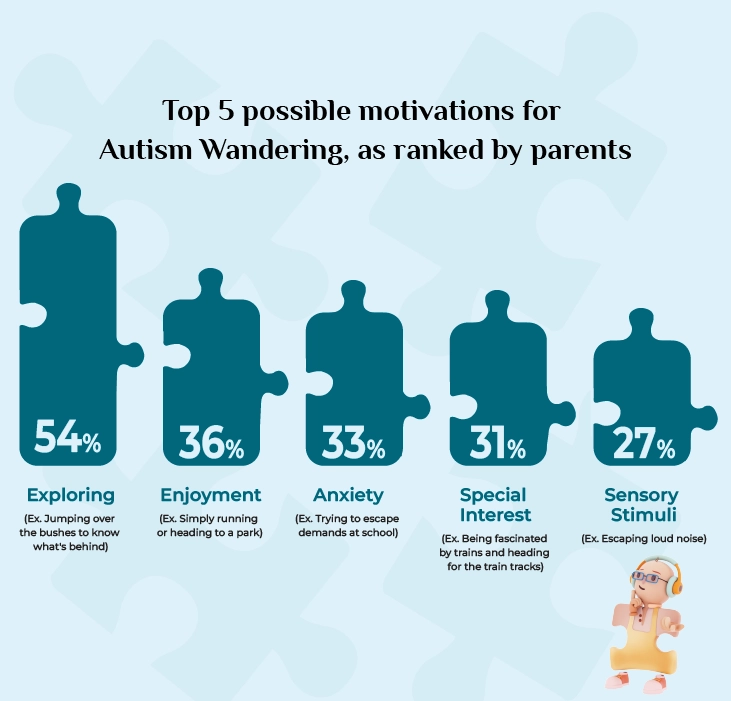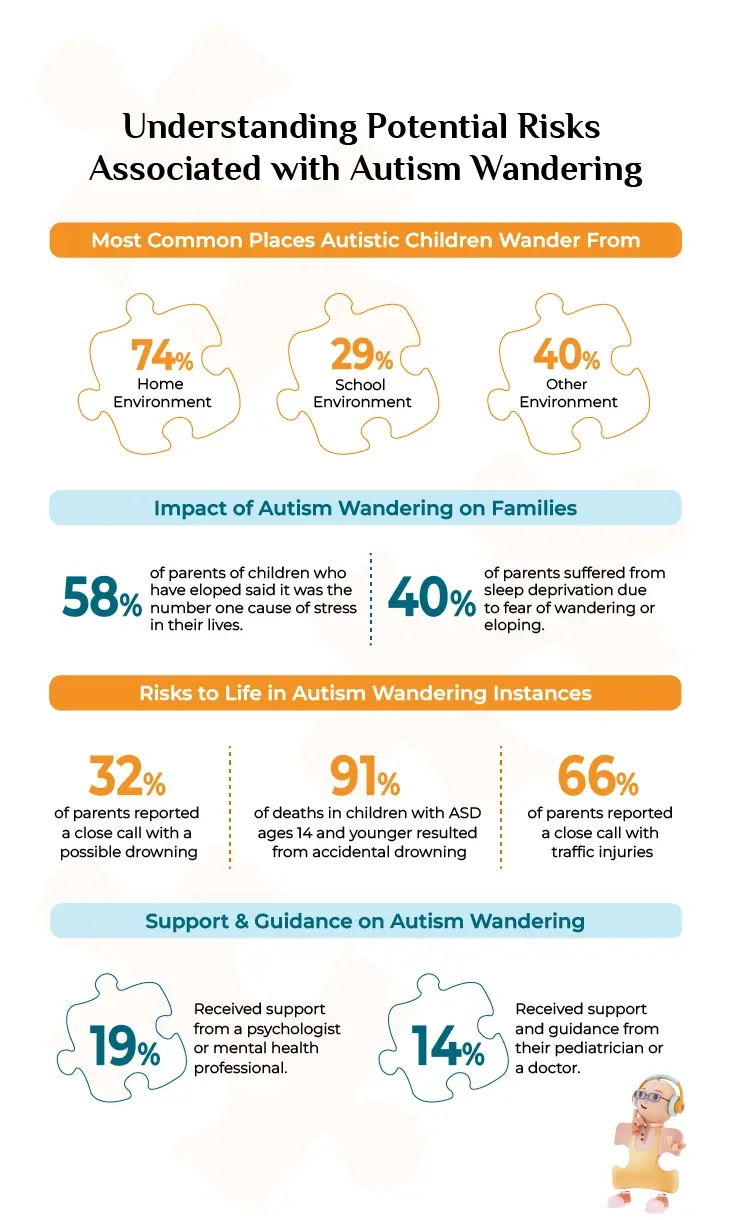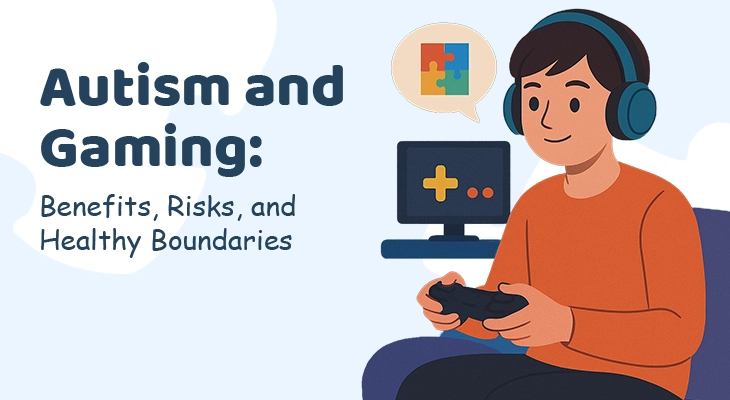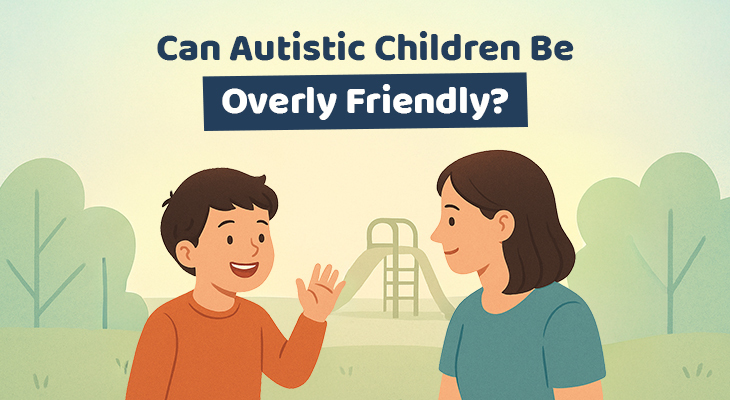In December 2017, four-year-old Chelsea Noel residing in Port St. Lucie embarked on a journey her family never anticipated. Diagnosed with autism and unable to speak, she wandered from her home, leaving a trail of fear and uncertainty in her wake. Her father, alerted to her absence within moments, rushed into the darkness outside, desperately searching for any sign of his daughter. He immediately called the police. The community, alerted by the police, also responded with unwavering support, tirelessly combing the streets in the hope of a safe return.
Though their search was exhaustive and their hope unwavering, the story of Chelsea, like many others, ended in a loss that continues to resonate deeply. Her journey serves as a reminder of the unique challenges faced by autistic children and the profound impact wandering can have on their families. [1]
In this blog let’s explore the complex world of autism wandering, uncovering the triggers, challenges, and strategies for keeping children safe.
What is autism wandering?
Autism wandering is the tendency for an autistic individual to leave a safe, supervised space or caregiver and subsequently expose oneself to potential danger. That might mean leaving the home when no one is looking, running away from school, disappearing among aisles in the supermarket, climbing over a fence to explore a nearby field or exiting through a fire escape.
Autistic individuals, because of their neurodivergent behavior, often have difficulties with communication and awareness of their own safety. Hence autism wandering is terrifying for parents and can prove to be tragic, given that drowning and wandering-related behaviors are the top causes of death in the ASD community.
Is autism wandering the same as eloping?
While “elope” traditionally implied running away and never coming back, the National Institute of Elopement Prevention and Resolution (NIEPR) has broadened its definition to encompass wanderings and departures from care settings by individuals with cognitive challenges or special needs [2]. So, while the terms carry slightly different historical connotations, their practical meaning in the context of autism is essentially identical.
Why do individuals with autism wander?
The unique way autistic individuals process information and interact with the world can contribute to their wandering behavior. While they may wander for various reasons, some typical triggers often fall into three categories:
- Destination-driven: This type of wandering involves a specific goal, often driven by a strong interest or fixation. Examples could include heading towards a body of water, train tracks, a park, a particular object, or a location of fascination.
- Escape-motivated: Wandering can be a way for some autistic children to cope with overwhelming situations or communicate their needs and is characterized by a sudden, impulsive move to get away from something unpleasant or overwhelming. Triggers could be bright lights, loud noises, commotion, anxiety, panic, excitement, stress, or unpleasant sensory input.
- Other factors: This category encompasses a broader range of triggers, such as disorientation, boredom, challenges with transitions, or simply getting lost. Additionally, night-time wandering and unexplained disappearances can also fall under this category.
It’s important to remember that these categories are not mutually exclusive, and an individual’s wandering may be influenced by a combination of factors. As per a blog by Child Mind Institute, parents ranked these as their child’s top five possible motivations [3].

Download Download & share this infograph in your network [Free Download]
Safety Concerns: Understanding Potential Risks Associated with Autism Wandering
While the open world can be a playground of discovery for autistic individuals, statistics show that the joy of wandering is very often overshadowed by the shadow of risk. And, it’s not just the child who faces potential dangers; the constant vigilance and emotional toll on caregivers is also immense.
-
What are the chances of wandering in autistic individuals?
- A 2012 study by the American Academy of Pediatrics revealed that, 49% of families that participated in the survey had at least one child with autism attempt to wander or elope.
- Chances of kids with ASD eloping or wandering is four times more likely to happen than their siblings without autism.
-
Who is at a higher risk for autism wandering?
- By age: Wandering or eloping among children with ASD typically happens between the ages of four and ten years. While the behavior peaks at 4 years, almost 30 percent of children with autism still elope between the ages of 7 and 10.
- By autism level: Eloping is more likely to occur among kids with severe autism, lower intellectual abilities, and communication difficulties.
-
To what extent might restricting enjoyable activities, especially outdoor ones, contribute to autism wandering?
- 62% of families where a child has eloped or wandered is one where they were not allowed to engage in activities they enjoyed, especially those involving stepping outside the house.
-
What are the most common places autistic children wander from?
- Home environment: 74% of the kids who eloped did so from either their own home or a known person’s home.
- School environment: 29% eloped from a classroom or school.
- Other environments: 40% of kids eloped from grocery stores.
-
What is the impact of autism wandering on families?
- More than half of the kids who had tried to elope went missing long enough to cause concern.
- 58% of parents of children who have eloped said it was the number one cause of stress in their lives.
- 40% of parents suffered from sleep deprivation due to fear of wandering or eloping.
-
What are the risks to life in wandering instances?
- 32% of parents reported a close call with a possible drowning.
- 91% of deaths in children with ASD ages 14 and younger resulted from accidental drowning in 2009, 2010, and 2011.
- The parents of two out of three missing children reported a close call with traffic injuries.
-
What makes autism wandering more risky?
- A third of children with ASD who wander or elope have difficulty communicating their name, address, or telephone number.
- Only 19 % of the parents said they received support from a psychologist or mental health professional.
- Only 14% had received support and guidance from their pediatrician or a doctor.

Download Download & share this infograph in your network [Free Download]
Strategies to prevent autism wandering
Strategies to prevent autism wandering is all about building a bridge of safety, empowering both parents and children to navigate the open road with confidence. Let’s explore practical strategies to minimize the risks and maximize the joy of exploration:
Key Supervision Strategies to Manage Autism Wandering Instances
- Minimize Distractions: When supervising a child with autism, eliminate multitasking and distractions like phones or loud conversations. Maintain close focus and actively engage with the child to anticipate potential triggers or wandering urges.
- Manage Routine Changes: Be aware that changes in routine, even positive ones like family gatherings or outings, can increase wandering risk. Prepare the child for these changes beforehand, establish clear boundaries, and maintain close supervision throughout the event.
- Prioritize Outdoor Supervision: Children with autism may require additional supervision outdoors, especially in unfamiliar environments or near potential hazards like roads or bodies of water. Implement clear safety rules, maintain awareness of surroundings, and consider using visual aids like ID bracelets.
Understanding Triggers to Reduce Autism Wandering Risks
- Identify and Map Triggers:
- Create a detailed list of triggers for wandering, including sensory sensitivities, emotional states, specific environments, or fixations.
- Share this list with trusted individuals like neighbors, teachers, and first responders to ensure everyone understands potential triggers.
- At home, proactively remove or manage triggers whenever possible.
- Develop and Practice Coping Strategies:
- Work with the child/individual to develop personalized coping mechanisms for dealing with identified triggers.
- Practice these strategies regularly in different environments until they become second nature and build confidence in managing triggers.
- Balance Restriction with Exploration:
- Remember, denying all enjoyable activities, especially those involving the outdoors, can backfire and increase elopement risk.
- Find a balance between preventing triggers and allowing safe exploration. Consider alternative activities or modifications to existing activities.
- Supervise and Prepare for Triggers:
- In potentially triggering situations, like a noisy supermarket, maintain close supervision or designate a trusted caregiver to watch the child while you run errands.
- Have a plan in place for responding to a potential elopement attempt, including clear communication protocols with all involved parties.
Teaching Safety Strategies for Wandering
- Visual Communication:
- Utilize picture cards, social stories, or other age-appropriate communication methods to educate your child about the potential dangers and risks of wandering.
- Use visual cues like red tape on doors and windows to designate “off-limits” zones and reinforce safety rules.
- Practice identifying and responding to safety signs like “Stop” or “Do Not Enter.”
- Essential Safety Information:
- Staying calm and remembering their name and address. Practice this regularly as 33% of children with ASD who wander or elope have difficulty communicating their name, address, or telephone number.
- Ensure your child carries some form of identification (ID bracelet, medical alert card) with their name, contact information, and any medical conditions.
- Discuss stranger danger and emphasize safe adults to approach for assistance (e.g., police officers, store employees).
- Navigating Unfamiliar Spaces: Teach your child specific skills for navigating unfamiliar spaces if they wander, such as:
- Basic road safety rules such as following sidewalks and staying away from the street, and car safety procedures, etc.
- Developing a plan for what to do if they get lost, including Asking for directions and using landmarks to retrace their steps.
- Teaching water safety basics and survival techniques, especially if you live near water.
- Home Environment:
- Secure your home boundaries with fencing, self-latching gates, and locked doors to minimize the risk of elopement.
- Consider installing door alarms or GPS tracking devices for additional peace of mind.
- Use Technology for Enhanced Safety:
- Upgrade to the latest school bus trackers that combine GPS with embedded RFID chips in your child’s ID badge as these chips provide real-time tracking not just during the commute but also within designated areas on school grounds.
- Explore GPS watches or bracelets for added monitoring, especially during outings or independent activities.
- Consider devices that offer features like geofencing (setting safe zones with alerts for entry/exit) and emergency SOS buttons.
Communicating Openly for Safety in School Settings
- Proactively inform the school and teachers about your child’s history of wandering. This transparency helps them understand potential triggers and prepare effective interventions.
- Initiate a dialogue with school authorities. Discuss their existing safety protocols and explore how they can be adapted to meet your child’s specific needs.
- Share your child’s unique triggers and coping mechanisms. This empowers teachers to anticipate potential challenges and implement appropriate strategies.
Reviewing and Refreshing Emergency Resources
- Regularly update contact information for local police, first responders, and emergency contacts.
- Create a list of places your child has a tendency to wander towards (ex. parks, bodies of water, specific streets, etc.) and share this list with trusted individuals like neighbors, teachers etc. & first responders.
- Discuss and reconfirm the Family Emergency Plan and roles for each member.
- Share updates on any changes in your child’s behavior, triggers, or preferred safety strategies with caregivers, teachers, and first responders.
Responding to Wandering Instances
Worries about wandering are a natural part of parenting an autistic child. Fortunately, there are effective strategies you can implement to increase safety and peace of mind. Let’s delve into some helpful resources.
- Stay Calm
- Panic can cloud judgment. Take deep breaths and focus on taking immediate steps.
- Assure any remaining family members and delegate tasks if needed.
- Call 911 Immediately
- Provide a clear description of your child, including clothing, age, and any unique identifiers.
- Mention your child’s autism and potential triggers (if known) to inform search efforts.
- Follow the dispatcher’s instructions and stay on the line for updates.
- Alert Your Network
- Neighbors: Inform them of your child’s disappearance and any details that might help identify them.
- Local police: File a missing person report and provide any additional information.
- Close relatives: Share the news and enlist their help in search efforts or providing support.
- Prioritize Safety Zones
- Water bodies: Immediately check nearby pools, lakes, rivers, and other potential drowning hazards.
- Familiar locations: Look for areas your child enjoys or has wandered to previously.
- Public spaces: Scan parks, playgrounds, and streets near your home.
- Additional Tips
- Leave a door or window open slightly to allow your child to return home independently.
- Use a familiar object or scent at the search base to attract them back.
- Prepare and distribute flyers with your child’s picture and information in case the search expands beyond your immediate area.
Conclusion
Wandering is a complex issue, not a reflection on parenting or caregiving. While autism wandering presents undeniable challenges, it’s important to remember that hope and proactive action can pave the path toward greater safety and freedom for both children and families.
Embrace the strategies we’ve explored: from understanding triggers and building safe environments to fostering open communication and utilizing technology. Remember, every child is unique, and their safety requires personalized solutions. By collaborating with educators, healthcare professionals, and trusted support networks, you can create a world where exploration and joy are interwoven with security and peace of mind.
Remember, you are not alone. This journey may have its twists and turns, but with the right tools and support, you can navigate it with confidence and create a brighter future for your child and yourself.
For information on autism monitoring, screening and testing please read our blog.
References
- Community mourns the loss of 4-year-old girl who wandered away from home
- The National Institute for Elopement Prevention and Resolution
- Autism & Wandering, Child Mind Institute
- National Autism Association
- About Autism and Wandering
- CDC – Key Findings: Children with Autism Spectrum Disorder More Likely to Wander than Children in Other Study Groups




